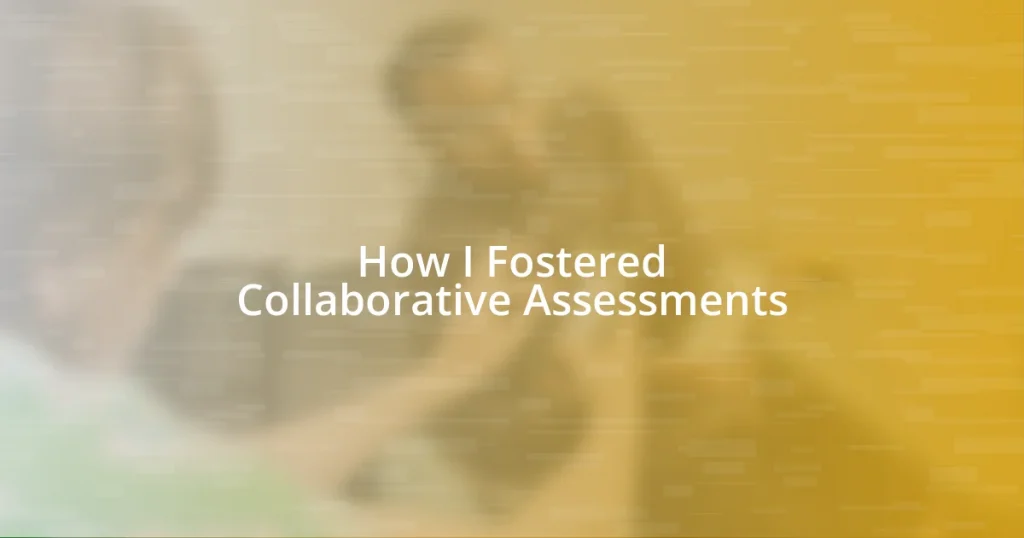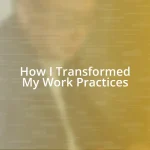Key takeaways:
- Collaborative assessments enhance student learning by promoting teamwork, critical thinking, and engagement, leading to improved social skills and a deeper understanding of concepts.
- Key strategies for effective implementation include establishing clear roles, integrating regular feedback sessions, and celebrating group achievements to foster ownership and community.
- Reflective practices, such as collaboration journals and discussions about the collaborative process, enhance personal growth and understanding of teamwork dynamics among students.

Understanding Collaborative Assessments
Collaborative assessments are a dynamic way of evaluating student learning through group efforts, where individuals contribute their unique strengths. I remember the first time I implemented this approach in my classroom; the excitement in the air was palpable as students transformed their individual ideas into a collective project. Have you ever witnessed a group ignite with creativity, surpassing what any single member could achieve?
The essence of collaborative assessments lies in their ability to foster not only teamwork but also deeper learning. I’ve seen reluctant learners shine when placed in cooperative settings, revealing talents that often go unnoticed in traditional assessment formats. Isn’t it fascinating how collaboration can break down barriers and build confidence among peers?
Moreover, these assessments can be designed to mirror real-world challenges, making the learning process more authentic and engaging. I recall a project where students researched local environmental issues and proposed solutions together. The passion they exhibited in finding answers for their community left me inspired and reminded me of the power of collaboration—how it transforms mere assessments into meaningful experiences.

Benefits of Collaborative Assessments
Collaborative assessments offer a myriad of benefits that can significantly enhance both learning and social skills among students. In my experience, I’ve witnessed how these assessments not only elevate understanding of the subject matter but also instill essential life skills. I distinctly remember a group project where students prepared a presentation on renewable energy sources. Watching them negotiate responsibilities and share perspectives reminded me just how essential collaboration is—not only for academic growth but also for fostering essential communication skills.
Here are some key benefits of collaborative assessments:
- Enhanced Critical Thinking: Working in groups encourages students to articulate their ideas, consider alternative viewpoints, and deepen their analysis of concepts.
- Improved Engagement: Students often feel more invested in learning when their voices are part of the collective effort, creating a sense of ownership over their education.
- Social Development: Collaborating with peers cultivates empathy, respect, and the ability to navigate interpersonal relationships, skills that are vital beyond the classroom.
- Diverse Perspectives: Group projects enable students to draw from a pool of diverse backgrounds and experiences, leading to richer discussions and innovative solutions.
- Shared Accountability: When students work together, they’re more likely to hold each other accountable, promoting responsibility and teamwork.
These benefits collectively create a robust learning environment where students thrive, and I can’t help but reflect on how that is a win-win for everyone involved.

Key Strategies for Implementation
One key strategy I found vital for implementing collaborative assessments is establishing clear roles within groups. By assigning specific responsibilities, I noticed students felt more ownership over their contributions. This reminds me of a time when I had my students divide tasks during a history project. Giving them titles like “researcher” or “presenter” transformed their approach—they relished their roles, and the result was a project that was cohesive and reflective of their collective strengths.
Another effective strategy is integrating regular feedback sessions. I can’t emphasize enough how important it is to have students share their progress and challenges throughout the collaborative process. I remember asking groups to present their ongoing work and discuss what they were learning. This not only kept everyone on track but also sparked meaningful discussions that led to deeper insights. It’s moments like these that showcase the power of collaboration; feedback becomes a catalyst for growth.
Lastly, celebrating group achievements fosters a sense of community within the classroom. When I took the time to highlight and appreciate each group’s hard work, I saw an increase in camaraderie and motivation among the students. I recall a lively showcase day where students presented their projects to parents and peers. The pride on their faces as they shared their collective accomplishments was unforgettable and underscored the value of collaboration in education.
| Strategy | Description |
|---|---|
| Establishing Clear Roles | Assign specific responsibilities to encourage ownership and accountability among students. |
| Regular Feedback Sessions | Integrate opportunities for groups to share progress and challenges, facilitating deeper learning through discussion. |
| Celebrating Achievements | Publicly recognize group efforts to build community and motivate students. |

Tools for Collaborative Assessments
When considering tools for collaborative assessments, digital platforms like Google Classroom or Microsoft Teams have become game changers in modern education. I remember the moment I introduced these tools to my students; their excitement was palpable. They loved being able to work in real-time and see each other’s contributions instantly. Doesn’t it create a more engaging atmosphere when everyone can actively participate in the same space, even if they’re miles apart?
Another valuable tool is the use of collaborative rubrics. Creating a rubric as a group not only helps set clear expectations, but it also encourages students to discuss what quality looks like. I once facilitated a session where students crafted their own criteria for a project. The discussions that emerged were enlightening; they debated ideas passionately, and I could see their understanding deepen as they grappled with the nuances of effective teamwork and quality work.
Lastly, I’ve found that incorporating peer-assessment tools, such as Padlet or Peergrade, can illuminate the collaborative process. It’s fascinating to see students reflect on each other’s contributions—there’s something empowering about being given a voice in assessing a peer’s work. I still recall when one of my quieter students provided thoughtful feedback that not only praised their partners but also suggested improvements. It was a wonderful example of how collaboration fosters mutual respect and personal growth. How often do we get to witness such transformation in a classroom setting?

Engaging Students in Collaboration
Engaging students in collaboration is all about creating an environment where they feel heard and valued. I remember one project where I encouraged students to brainstorm as a group right at the start. The transformation was instant—ideas flowed freely, and every voice mattered. It was a beautiful reminder that collaboration isn’t just about completing a task; it’s about the joy of discovering new ideas together.
Another approach that really resonated with my students was using icebreaker activities before diving into group work. I found that when students bonded over light-hearted games or sharing personal stories, they entered collaborative tasks more open and eager to cooperate. One time, a simple activity involving drawing each other’s favorite hobbies brought laughter and broke down barriers—suddenly, they felt like friends on a journey together, rather than just classmates tackling an assignment.
Let’s not forget the power of reflection. After completing group projects, I’d ask my students to share their experiences—what they enjoyed and what challenges they faced. This reflective practice not only deepened their understanding of collaboration but also cultivated empathy among them. They learned to appreciate each other’s perspectives, realizing that everyone brings unique strengths and challenges to the table. Have you ever noticed how much richer our experiences become when we take the time to reflect and understand one another? It’s those moments of connection that truly elevate collaborative learning.

Assessing Collaborative Learning Outcomes
Assessing collaborative learning outcomes goes beyond just evaluating the final product. I remember a group project where students created a presentation together. Rather than solely focusing on the presentation itself, I devised a method for them to assess their collaborative process along the way. The students tracked their contributions and reflected on their teamwork, which opened up a dialogue about what worked and what didn’t. It’s remarkable how much insight they gained from discussing their dynamics; it highlighted the importance of teamwork as an essential skill in their education.
In one instance, a group of my students faced significant conflict during a project. Instead of ignoring it, I encouraged them to assess their interactions with a guided questionnaire that asked them about their communication, decision-making processes, and conflict resolution strategies. The responses were eye-opening! Students shared their frustrations and joys honestly, and it turned into a learning moment where they developed a deeper understanding of how collaboration can thrive, even amid challenges. Have you ever noticed how conflict can often lead to growth in teamwork when addressed properly?
Another assessment method I’ve found effective is digital storytelling. After completing a collaborative project, I invited my students to create short videos reflecting on their experiences, showcasing both their individual roles and the collective effort. The excitement in their voices as they narrated their journeys was contagious! Many shared personal growth stories, expressing newfound skills or friendships forged during the project. This type of reflective assessment not only provided insight into their outcomes but also captured the essence of collaborative learning on a personal level. Doesn’t it make you appreciate how powerful storytelling can be in assessing learning outcomes?

Reflecting on Collaborative Practices
Reflecting on collaborative practices has always been a pivotal part of my teaching approach. I recall a moment after a particularly challenging group project, where students gathered to discuss not just the outcome but how they collaborated. Some shared moments of frustration, and honestly, it felt cathartic to hear their stories. It made me realize that these reflections help them understand the emotional landscape of teamwork—how joy, tension, and compromise intertwine to create meaningful experiences. Have you ever noticed how reflection can be the key to unlocking deeper learning?
During another project, I implemented a “collaboration journal” where students recorded their thoughts and feelings throughout their work together. The entries varied from excitement about breakthroughs to concerns about uneven contributions. Reading through their candid reflections shed light on their evolving dynamics. This exercise taught me that written reflection can sometimes surface insights more profound than verbal discussions ever could. Wouldn’t you agree that having a space to record one’s thoughts fosters a more honest dialogue?
Ultimately, I found that these reflective practices didn’t just close the loop on collaborative assignments; they enriched the entire learning experience. One student once told me that writing about her struggle to voice her ideas in a group made her feel empowered to be more vocal in future collaborations. This personal growth reminded me that reflection is not merely about assessing what happened but about nurturing each individual’s journey within the collaborative framework. Isn’t it fascinating how reflection can illuminate pathways for personal development?















